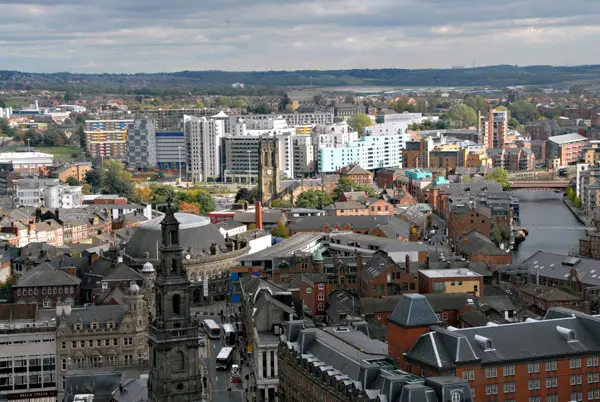Cenex and consortium to trial ‘active geofencing’ to control vehicle emissions in Leeds

The UK’s first Center of Excellence for low carbon technologies, Cenex, has launched a demonstration program to take place in the city of Leeds that will improve air quality by giving local authorities the technology to control city vehicle emissions.
Cenex and Leeds City Council have unveiled Project ACCRA, a collaboration that also includes the Transport Systems Catapult (TSC), EarthSense, Dynniq, and Tevva Motors. The project will showcase smart city technology applications that demonstrate real-time emissions control, using live air quality data to trigger electric hybrid engines to automatically switch to zero-emission running in heavily polluted areas. The project will be demonstrated in Leeds (above) and promises to offer cities new ways to reduce urban air pollution.
A consortium of automotive innovators, coordinated by the TSC’s intelligent mobility experts, will collaborate to capture real-time air quality readings that will trigger hybrid electric engines to switch automatically to zero-emission running. Known as ‘active geofencing’, the technology concept will be tested on a hybrid commercial vehicle interface developed by Tevva Motors that uses a small capacity diesel engine, providing power to a generator that drives an electric motor to power the truck’s wheels.
Transportation network systems developer Dynniq will develop a decision-making software engine capable of taking inputs from a range of city data, such as live air quality information and real-time traffic conditions. EarthSense will be responsible for monitoring and uploading updated local air quality levels to the interface, which will be used to trigger on-demand zero-emissions running instructions in the participating Tevva vehicles.
Cenex and the TSC will evaluate the application, markets, business models and scalability of the system in hopes of using the technology more widely in Leeds and potential UK Clean Air Zones (CAZs) in the country’s most polluted cities. Local and national policymakers are introducing increasingly strict regulation on urban transportation, however, the complexity of implementing strict emissions controls in specific areas can come with additional costs to local councils, motorists and businesses.
“Local air quality is a persistent and growing problem in urban centers across the UK and globally,” noted Steve Carroll, Cenex’s head of transport. “Using real-time air quality data to automatically instruct vehicles driving into high pollution areas to switch to zero-emissions driving, has the potential to transform urban transportation regulation and save thousands of lives.”
Paul Bate, TSC’s principal technologist, added, “Vehicle-to-infrastructure (V2I) communication has the promise to transform how cities manage urban traffic control and air quality regulation.”















![AIRBUS A380 [MORE THAN 600 PASSENGER’S CAPACITY PLANE]](https://cdn.tinn.ir/thumbnail/4jCp4EQvCU0b/IjHVrSYQrIAqIzXuTzADR7qLYX4idQT4nfq__26E5SCUPLMqfhWkWajvuO9Wfq1ql1TjV4dhkrHliNQU82kMpo2NNftT_NGEwHc9KXtN_rk731bmifa2IQ,,/airbus-a380-structure1.jpg)

Send Comment